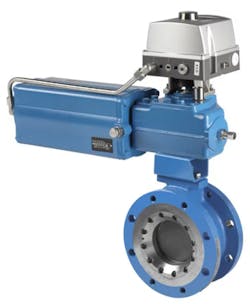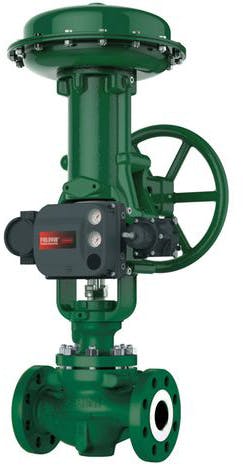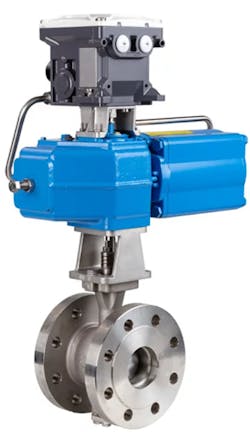Globe control valves were developed and put into use more than a century ago. Not only are they the original, but for a long period of time, they were the only type of control valve available. However, there have been some substantial advancements in the field of control valves in the last 20 to 50 years. These advancements have led to the design of more modern rotary control valves that offer many advantages over their globe control valve ancestors.
That is not to say that globe control valves are completely obsolete. There is still a place for them in the process industry. Most notably, a globe control valve is still the most appropriate when the process contains an extraordinarily high pressure drop across the valve. However, due to the higher price tag (among other disadvantages), there should certainly be a great deal of thought given to whether a globe control valve is necessary for a certain application. Alternatively, a less expensive rotary valve could be a more suitable solution.
Inherent design limitations
One of the characteristics of the globe control valve that makes it less than suitable for a number of different applications is its rising stem design. While effective at controlling the plug, this rising stem inevitably runs the risk of dragging process fluid out into the environment through the stem packing. Conversely, this design can also bring contaminants from the environment back into the system. The back-and-forth travel of the stem through the packing wears the packing quickly and leads to frequent packing leaks.
The rotary valve, on the other hand, is designed so that the stem or shaft rotates within the stem seal. This results in less stress on the packing and a longer seal life. This also means that if an operator is processing something toxic or something that causes pollution, the rotary valve will keep it sealed within the process better and longer.
Another limitation is flow capacity, measured in CV. The long, tortuous flow path through the body of the globe valve, and the restriction at the plug and seat, limit the amount of flow that can pass through it. Most rotary valves, especially butterfly, ball and segmented ball (V-Ball) types, have two or three times the flow capacity of a globe control valve of the same size.
Physical size
The ANSI/ASME standard face-to-face length of globe valves is longer than rotary valves such as ball valves, segmented ball and especially butterfly valves of the same line size. And globe valves of the same line size and material typically weigh more and cost more than their rotary counterparts.
The same goes for the actuation package, as well. When observing the actuator on a globe valve, one can see that it is usually quite tall and sticking out above the valve quite a bit. This can be problematic in locations that require tight packaging to fit the process equipment into the available space.
Contributing to this problem, as the differential pressure across an unbalanced globe valve increases, the required thrust — and thus the size of the actuator — will increase along with it in a linear fashion. This can be offset to some extent by using a more expensive balanced globe valve — if the process properties allow.
With a rotary valve, however, there is much less of an increase in actuator size as the differential pressure increases across the valve. Particularly in high-pressure applications, if the rotary valve is appropriate, the actuator package will be quite a bit less expensive along with being smaller and lighter.
In addition, and as previously mentioned, the CV (valve capacity) of a rotary valve tends to be higher than that of a globe valve of the same nominal size. This means one can get more flow through a rotary valve at the same pressure drop. Ultimately, this results in the ability to use a smaller rotary valve as opposed to a larger globe valve for the same application. This reduces the size, weight and cost of the control valve package.
Inherent and installed characteristics
There are certainly advantages that globe valves have over rotary valves in certain applications. For example, a globe valve has interchangeable trim, which offers two potential benefits. First, different size trims can allow a process to be built for an initially smaller capacity and then replaced with larger trim as capacity needs increase. Or, if a mistake was made during the original design, a different trim size can be installed to correct the mistake without having to replace the entire valve. The second benefit is to allow an operator to choose between an equal percent or a linear inherent characteristic. This linear trim option can be an advantage for high pressure drop applications.
However, the vast majority of control valve applications require an equal percent characteristic, which happens to be the inherent characteristic of most rotary valves. This fact makes them often the most appropriate choice for the bulk of control applications.
Computational fluid dynamics
Computation fluid dynamics allows engineers to predict cavitation and noise generation in a valve. Anyone who has experience working with valves of any kind understands the negative effects that cavitation can have in a process. If left unaddressed, cavitation or high noise levels can lead to equipment failure and, in some cases, a complete shutdown of an operation. With computational fluid dynamics, engineers are equipped to analyze a valve for a specific application before it is built. This allows the owner to be confident that selecting a lower cost rotary valve will not compromise the performance or safety of their process.
One advantage that globe valves have over most of their rotary valve counterparts is their high recovery factor, which helps to prevent cavitation from occurring. For this reason, some in the process industry are hesitant to go with the less expensive rotary option and instead stick with the traditional globe valve design. With computational fluid dynamics, engineers can analyze the loop to verify that the rotary valve will work or be warned that a globe valve or a rotary valve with special modifications is, in fact, required.
As discussed, there are certain situations where the more expensive globe valve is still a viable solution for the application. These situations typically occur where there are high pressure drops across the valve and when there is a high likelihood of cavitation. However, in most other scenarios, there is a sizable advantage in specifying a rotary valve instead. It is typically smaller in size, well equipped to handle an equal percent characteristic requirement and perhaps most important, far less expensive.
Peter Jessee, P.E., is a process control application engineer for Valin Corporation, a leading technical solutions provider for the technology, energy, life sciences, natural resources and transportation industries. Valin offers personalized order management, on-site field support, comprehensive training and applied expert engineering services utilizing automation, fluid management, precision measurement, process heating, and filtration products.
Valin Corporation




